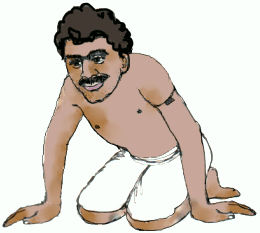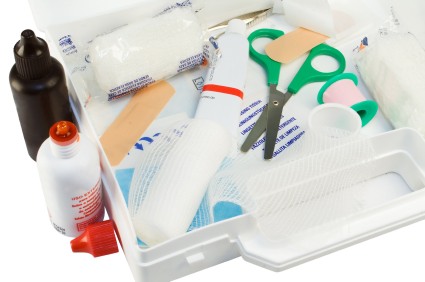
Snake People []
Written by Zai and Rom Whitaker
Illustrations by Shekar Dattatri
Published by National Book Trust, New Delhi
This fascinating book gives us glimpses of the lives of the Irula tribals of Tamil Nadu, who are great snake catchers. The authors, who run a snake park in south India, have worked with these “snake people” for over a decade, and talk about their snake-catching abilities. They also talk about “snake people” in other parts of the world, who are great names in the world of research on snakes.
An excerpt from the book:
Most people are ready to flee the moment they see a snake. But there are also those who actively seek out snakes. When, for example, millions of snake skins were being sent abroad from India every year, some people became professional snake-catchers. They earned their living by catching snakes and selling their skins. They mostly caught the large land snakes like the rat snake, cobra, Russell’s viper, python and sand boa.
4_2.gif
In southern India, it was the Irula tribals of Tamil Nadu, who supplied most of the skins for export. We have worked with them for over ten years, and admire their magical talent for finding snakes. Chockalingam and Rajendran, Raman and Vellai and our many other Irula friends know more about snakes than you or we could ever hope to.
One of them has only to see a faint track in the sand, bend down to study it, and he can tell you that it was a small cobra which passed that way barley ten minutes ago. He follows the track, and hundred metres away, comes to a rat hole in a patch of scrub forest. Dig, dig, dig with a crowbar and yes! The cobra is at home: there is a smooth, very fresh track going into the hole. More digging as the burrow bends this way and that, till finally a tail appears. A furious cobra is pulled out, hissing angrily at having its afternoon rest so rudely disturbed.
The export of snake skins is now banned, and some Irulas catch snakes for their venom instead. This is sold to the Serum Institute in Pune, the King Institute in Madras and other laboratories where anti-venom serum is made. The Irulas have formed a society called the Irula Snake-catchers Cooperative Society where snakes are brought and stored in cool mud pots.
Their venom is extracted three times. The snake is caught behind the neck and held over a rubber sheet stretched over a glass. Angry and frightened, the snake is eager to defend itself and bites into the sheet. After three such extractions a week apart, the snake is released back into the forest and the venom dried into a powder and sold.
Many states have communities of snake-catchers. The Mahrs of Maharshtra catch the small saw-scaled vipers for the Haffkine Institute, which also makes anti-venom serum.
Outside Bhubaneswar in Orissa is Patia, a small village of snake charmers. These snake people, all surnamed Das, specialise in catching the king cobra which lives in the mangrove swamps of the Orissa coast. They defang the snakes and carry them around the countryside, displaying them in the big cities.
There is, however, one kind of snake-catcher who most of us have come across. A neighbour in Bombay once asked a “snake-catcher” to rid his compound of snakes and we watched him get to work. Asking everyone to stand back, he walked around the garden playing his flute.
Suddenly, he jumped behind a bush and came out holding a struggling cobra by the tail. Everyone gasped, and he went on to pull out four more snakes from our friend’s small compound, mostly harmless sand boas, which he assured us were vipers. On checking, the cobras more closely we found that they had already been neatly defanged. This cunning fellow had bought his own snakes with him!
The snake-charmer who you see on the streets with his flute and basket is not a snake-catcher at all. He buys cobras from people who go out and catch them, and tears the fangs out for his safety. Sometimes the snake’s mouth is cruelly stitched together. Naturally, all this makes the snake very sick. It cannot eat without teeth and dies within a month or two. The cobra you see “dancing” to the snake-charmer’s flute is actually a very sick, frightened animal tired of life.
Snakes are worshipped in many countries of the world. In India, the gods Shiva and Vishnu are often shown with a snake, and there is even a goddess of snakebite. In Battis Shirala in Maharashtra, during the harvest festival of Nag Panchmi, men, women and children worship freshly caught cobras with flowers, ghee and money.
In the United States, there are Christian groups who believe that if you have faith, even a venomous snake cannot harm you. They have meetings where rattlesnakes and other venomous snakes are kept in boxes. People step forward, put their hands inside the boxes and pull out the snakes. They believe that even if bitten the person won’t die. This has had fatal results.
The Shans of Burma have a strange ritual. An expert snake-catcher goes into the forest and brings back a huge king cobra. On an auspicious day, the snake is taken to an open field and people surround it. Its basket is opened and as it rises to its full height, hood spread, a girl walks forward, leans over and kisses it on top of the head.
4_3.gif
Some people eat snakes. There are restaurants in Hong Kong where you can choose the one you want from a cage full of live snakes. Your choice is then killed and cooked for you. In the Indonesian province of Irian Jaya, Rom was invited to a Christmas feast by the Korodesis on the Rouffaer river. One of the delicacies was steamed python! (He reports that it tasted good, a lot like chicken.) In our own country, tribes like the Chakmas of the north-east and the Poliyars of the south-west make snakes a regular part of their diet. To others, the fat and meat are valuable as medicines.
In the world of research on snakes, some names have become legendary. Raymond Ditmars, the curator of the Bronx Zoo in New York perhaps did more than anyone else to popularise snakes and encourage young people to learn about them. His book, Snakes of the World was the bible of young snake lovers in the United States. PJP Ionides, an English army officer who settled in Africa, was a hunter and snake-catcher, renowned for his courage. He caught mambas, boomslangs, puff adders and other deadly African snakes for zoos and venom centres all over the world.
But for many, the guru of snake-men is Bill Haast, who until recently had a snake park in Miami, Florida. He extracts the venoms of snakes from all over the world: cobras and kraits from India and Pakistan, king cobras from Thailand, puff adders and mambas from Africa, Australian tiger snakes and taipans — and hundreds more.
But he is most famous for the way he handles and extracts venom from the massive, four-and-a-half-metre king cobra. He takes the king cobra out of its box and handles it directly without tongs, a snakes hook or any other instrument. Again and again, he amazes visitors by the agile, calm way with which he faces the world’s deadliest snakes. No one has been known to survive the bite of the king cobra except Bill Haast. And how do you think he manages this?
When young, he decided to immunise himself against certain snake venoms, and just as we get vaccinated against cholera and typhoid he injected himself with bigger and bigger doses of snake venoms, till his body built up an immunity to them. Someone joked that he had so much venom in his blood “that he better not bite anyone”.
Anyway, this has saved him when bitten by the king cobra — he could not have survived otherwise. He has had over a hundred bites from venomous snakes.










